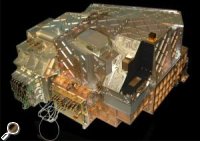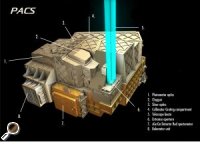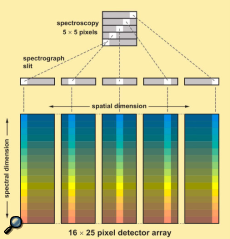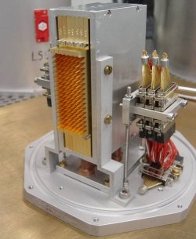 |
|||
| HOME | ISO | HERSCHEL |
JWST |
The PACS instrument
|
|
The Photoconducting Array Camera and Spectrometer PACS provides HERSCHEL with far-infrared imaging and spectroscopic capabilities from 60 to 210 μm. It hosts four detector arrays consisting of two bolometer arrays and two Ge:Ga photo-conductor arrays. The bolometer arrays are dedicated for imaging and photometry, while the photo-conductor arrays are used for pointed and integral field spectroscopy leading to images at individual wavelengths or selected ranges of the spectral bands. The MPIA is the largest co-investigator institute participating in the PACS instrument which was developed jointly by eleven European institutes under the leadership of the Max Planck Institute for Extraterrestrial Physics (MPE) in Garching, Germany. PACS turned out to be the instrument most strongly requested by scientists and has a share of HERSCHEL operations of more than 50%.
PACS Chopper
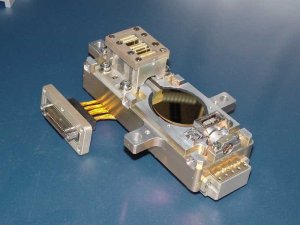
|
| Fig.3: Flight model of the PACS focal plane chopper. The gold-plated mirror has a major axis length of 32 mm. On the lower right side, one of the suspensions in a Cu:Be flexural pivot are visible; the three motor coils located to the left are made of 10 μm high-purity Al wires. |
In order to precisely measure the weak signal of a cosmic source against the large thermal background signal of the 80-90 K "warm" HERSCHEL telescope, PACS is operated with a focal plane chopper. This device (see Fig. 3) is a 32 x 26 mm2 "tipping" ("chopping") mirror comparing two neighbouring sections of the sky by using a square-wave modulation with frequencies of up to 1.25 Hz. By subtracting the background radiation identical in both fields, the brightness of the cosmic source can be extracted. The chopper has also been proven to be useful to identify long term thermal and instrumental trends. It is one of MPIA’s important contributions to PACS. After a successful prototyping phase at the institute, the company Carl Zeiss in Oberkochen, Germany, has been selected as the industrial contractor for building the flight models of the chopper. To prove the demanding specifications, several models of the chopper had to be manufactured: A lifetime model successfully passed 650 million chopper movements at an operating temperature of −270°C. Additional flight spare models were built to substitute flight models in the case of damage or other problems with the flight model. They are now being used as a laboratory twin of the flight model in order to verify and test its behaviour in space.
Ge:Ga detectors
MPIA is also responsible for the characterisation of the PACS far-infrared low stressed Gallium doped Germanium (Ge:Ga) detectors as used in the integral field spectrometer of the PACS instrument (Fig. 5). The observed field of 5 x 5 spatial pixels is converted into a single row of 25 signals by an image slicer and is then dispersed via a grating. The resulting spectra are analysed by the 16 x 25 pixel Ge:Ga photo-conductors with the rows of 25 elements representing the spatial information and the 16 columns containing the dispersed spectra. Two wavelength ranges can be observed simultaneously (called blue and red covering 55-105 μm and 105-210 μm, respectively).
Pre-flight Test Support
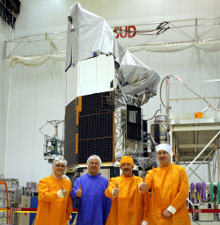
|
| Fig.6: The HERSCHEL satellite in the cleanroom of the test facility S1B of Europe's space port in Kourou, French Guiana. In front of the satellite, the PACS test team gives green light for launch after a last successful functional test of the instrument. (Click on image to enlarge) |
After the work for the instrument was completed at MPIA, a phase of intense testing followed and extended until the launch of the telescope. Scientists from Heidelberg were heavily involved in the cold and warm tests of the PACS flight model at MPE in Garching.
Upon integration of the HERSCHEL 3.5m mirror onto the cryostat assembly and the cool-down of the instruments to liquid helium temperature at the European Space Agency (ESA) technology centre ESTEC in Noordwijk (NL), a series of tests of all instrument components and software systems was conducted including an end-to-end test simulating the observatory operations with the satellite in the Large Space Simulator Chamber. The instrument had to survive 15 cold-warm cycles (−270°C → +300°C → −270°C). These tests comprised a large number of short functional tests before and after shaking the whole satellite and simulating an Ariane 5 rocket launch that exerts acceleration loads of up to 30 times the Earth’s gravity. A final set of functional tests were executed just before the launch after the transport of the HERSCHEL satellite to the Kourou spaceport in French Guiana.
Instrument Control Centre
After successful delivery and check-out of the PACS hardware contributions, MPIA is now heavily involved in many PACS Instrument Control Center tasks. The Instrument Control Centre (ICC), located at the PI institute MPE in Garching, has the responsibility for operations, calibration and data quality of the PACS instrument. MPIA is one of four institutes of the PACS consortium which are main manpower contributors to the PACS ICC. MPIA coordinates the calibration of the PACS instrument and has been responsible for establishing the PACS Performance Verification Phase plan, the central PACS calibration document and the PACS Routine Science Phase calibration. The MPIA is also reponsible for the revision and approval of HERSCHEL operational days that contain PACS calibration or engineering observations.
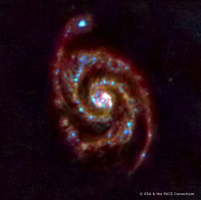
|
| Fig.7: Image of M51 obtained as the first scientific HERSCHEL image during the so called Sneak Preview, immediately after cryo cover opening, on HERSCHEL's 32nd operational day. This composite image has been created from images in the three PACS bands at 70, 100, and 160 μm. (Click on image to enlarge) |
During the two months lasting Commissioning Phase the coordination of all PACS instrument activities and their mission planning was executed by the MPIA team. It also ensured the optimum in-flight set-up of the Ge:Ga spectrometer detector arrays following a procedure developed in the MPIA lab. All 64 operational days of the PACS instrument and HERSCHEL telescope pointing performance verification, lasting from mid July until end of November, were coordinated and scheduled by the MPIA ICC team, which also maintained the overall PV Plan. This also included the planning for the first light images of HERSCHEL. The PV activity established an initial calibration in space and verified the validity of astronomical observation templates (AOTs), which are the basic observing blocks to be used by all observers later. Setting up the PV plan was a complex and challenging task since a large number of boundary conditions, such as source visibilities and properties as well as interdependencies of observations, had to be accounted for in the mission planning. The MPIA team has exclusively carried out the detailed mission planning of all PACS PV phase operational days, utilising dedicated software tools, and has delivered the observational data bases to the HERSCHEL Science Center at ESAC in Villafranca (Spain) and the Mission Operations Center at ESOC in Darmstadt (Germany). The principles of planning and executing calibration observations still hold during the Routine Science Phase (RSP), although only a few hours during an observing cycle of 14 days are reserved for PACS calibration.
By the end of 2009, the PACS spectrometer pipeline, which had been built with significant contributions and under the coordination of MPIA, had already reached the maturity to populate the HERSCHEL archive with science products. Currently, the MPIA is taking a lead role in optimising the calibration and data quality that is affected by pointing inaccuracies.
The photometric calibration of the PACS photometer is another important task in which the MPIA plays a key role. Together with colleagues of the MPE, the accuracy of point sources measured with the PACS photometer has already been pushed beyond the initial expectations. The remaining uncertainties are dominated by the models of the standard sources, which are accurate to 5%. By analysing calibration data that were obtained throughout the entire HERSCHEL mission, and in which the PACS chopper is a crucial tool, the prospects are that by calibrating out thermal effects of the telescope mirror and the bolometer cooler, the relative point source calibration accuracy will be of the order of 0.5%.
 click here to get a printer-friendly version of this page click here to get a printer-friendly version of this page |
|
last modified: 25 Feb 2013 for questions or comments please contact the webmaster |

